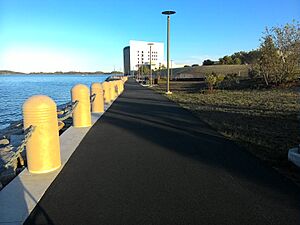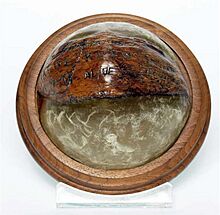John F. Kennedy Presidential Library and Museum facts for kids
Quick facts for kids John F. Kennedy Presidential Library and Museum |
|
|---|---|
 |
|
 |
|
| General information | |
| Location | Boston, Suffolk County, Massachusetts, United States |
| Coordinates | 42°18′57.21″N 71°2′2.71″W / 42.3158917°N 71.0340861°W |
| Named for | John Fitzgerald Kennedy (1917–1963) |
| Construction started | August 1977 Groundbreaking: June 12, 1977 |
| Inaugurated | Dedicated on October 20, 1979 Rededicated on October 29, 1993 |
| Cost | $20.8 million |
| Management | National Archives and Records Administration |
| Technical details | |
| Size | 10 acres (40,000 m2) |
| Design and construction | |
| Architect | I. M. Pei |
The John F. Kennedy Presidential Library and Museum is the official library and museum for John F. Kennedy (JFK), the 35th president of the United States. It is located in Boston, Massachusetts, on a spot called Columbia Point.
This special building holds the original papers and records from Kennedy's time as president. It also has materials about his life and even a collection of items from the famous author Ernest Hemingway. The library was designed by the architect I. M. Pei. It is part of the Presidential Library System, which is run by the U.S. National Archives and Records Administration.
The library and museum officially opened in 1979. President Jimmy Carter and members of the Kennedy family attended the opening ceremony.
Contents
The Story of the Library
An Idea from President Kennedy
Before his death, President Kennedy wanted to build a library. He looked at several spots near Harvard University, where he had gone to college. At the time, there were only four other presidential libraries, and Kennedy felt they were too far from universities and researchers.
Kennedy wanted his library to be more than just a place for his papers. He wanted it to be a museum that told the complete story of his presidency. That's why "Museum" is part of its official name.
After President Kennedy was assassinated in 1963, his family and friends worked to make his dream a reality. His wife, Jacqueline Kennedy, was in charge of the final decisions. She and a committee met with famous architects from all over the world to find the right person to design the library.
Finding a Home for the Library
The project faced many challenges. The first chosen location was near Harvard University in Cambridge, Massachusetts. However, some local residents worried that the library would bring too much traffic and tourism to their neighborhood.
Because of these concerns, the Kennedy family decided to find a new location. They wanted the library to be a happy place, not one surrounded by disagreement.
In 1975, a new site was chosen on Columbia Point, next to the University of Massachusetts Boston. The land was once a garbage dump, but it had a beautiful view of the water. The groundbreaking ceremony took place on June 12, 1977, and construction began a few months later.
A Modern Design by I. M. Pei
Jacqueline Kennedy chose I. M. Pei to be the architect. He was not the most famous choice at the time, but she liked his creative ideas. She said he was "so full of promise, like Jack," referring to her husband.
Pei designed a modern building with simple geometric shapes. It includes a 125-foot-tall tower made of concrete, a round building with two theaters, and a large pavilion made of gray glass. The building cost $20.8 million, with donations coming from over 30 million people.
The library was officially dedicated on October 20, 1979. At the ceremony, President Jimmy Carter and Senator Ted Kennedy, John F. Kennedy's brother, gave speeches honoring the late president.
What's Inside the Museum?
The museum has seven permanent exhibits that tell the story of President Kennedy and his time. Visitors start by watching a short film about his life.
- Campaign Trail: This exhibit is about the 1960 presidential campaign. You can see items from the campaign and a replica of a Kennedy campaign office.
- The Briefing Room: Here, you can learn about Kennedy's famous speeches and press conferences.
- The Space Race: This area focuses on the race to space between the United States and the Soviet Union. For many years, it displayed the Freedom 7 space capsule, which carried Alan Shepard, the first American in space.
- Attorney General's Office: This exhibit is about Robert F. Kennedy, the president's brother, who served as Attorney General. It shows his work on civil rights and fighting crime.
- The Oval Office: This exhibit includes a replica of the Resolute desk and other items Kennedy kept in the Oval Office. It also covers the American Civil Rights Movement during his presidency.
- First Lady Jacqueline Bouvier Kennedy: Learn about the life of the First Lady, Jacqueline Kennedy. The exhibit features videos and some of her famous clothing.
- The Kennedy Family: This section explores the history of the famous Kennedy family with personal items and artifacts.
The library also displays President Kennedy's sailboat, the Victura. He got the boat when he was 15, and it was very important to him and his family.
Special Collections
Archives and Recordings
The library's archives hold millions of important documents. There are also over 400,000 photographs, thousands of hours of film, and thousands of audio recordings.
One special project is the oral-history collection. Starting in 1964, the library recorded interviews with over 1,100 people who knew or worked with President Kennedy. These interviews provide a personal look at his life and career.
A famous artifact in the collection is the coconut shell that Kennedy used to send a rescue message during World War II. He carved a message on it after his boat, the PT-109, was sunk.
The Ernest Hemingway Collection
The library is also the main center for studying the life and work of author Ernest Hemingway. His widow, Mary Hemingway, decided to donate his papers to the library in 1968.
The collection includes:
- Over 1,000 of Hemingway's manuscripts, including early drafts of his famous novels.
- Thousands of letters between Hemingway and other famous writers, like F. Scott Fitzgerald and William Faulkner.
- More than 10,000 photographs from his life.
- Books from his personal library, many with his notes written in them.
Recent Events
In 2013, a small fire occurred in a mechanical room but was quickly put out. Officials confirmed it had no connection to the Boston Marathon bombing, which happened on the same day.
In early 2025, the library closed for one day due to a government directive but reopened the next day with free admission for visitors.
See also
 In Spanish: Biblioteca y Museo Presidencial de John F. Kennedy para niños
In Spanish: Biblioteca y Museo Presidencial de John F. Kennedy para niños
- List of memorials to John F. Kennedy
- Presidential memorials in the United States
Images for kids







